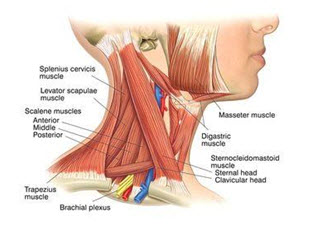Why the Scaleni Deserve a Good Stretch
Scaleni what? While the scaleni (plural), or scalene muscles, aren’t as familiar as the pecs, abs, and biceps, or for that matter the glutes, quads, and triceps, they are an important muscle group from the standpoint of their location in relationship to a major neurovascular bundle.
The scaleni are comprised of the anterior, middle, and posterior scalene muscles which originate from the transverse processes of the cervical vertebrae and descend at a slight angle to insert on either the first or second rib. As paired, lateral neck muscles, they are flexors and rotators of the head and neck and also function as accessory muscles of inspiration. Passing between the anterior and middle scalene is the brachial plexus of nerves and the subclavian artery. The brachial plexus innervates the upper extremity and the subclavian artery supplies blood to the arms with some branches of the right vessel supplying a portion of the head and thorax.

With today’s prevalence of computer and cell phone use, a forward head posture is oftentimes assumed which together with a lack of back muscle strength can lead to contracted scalene and pectoralis muscles. This taut condition can lead to compression on the neurovascular bundle where it passes through the anterior and middle scalene muscles. Clinically, this is described as thoracic outlet syndrome with pain exhibited in the hand, forearm, upper arm, or pectoral region. The symptoms of pain in the hand can be similar to that of carpal tunnel syndrome with aching, burning, numbness, and a pins and needles sensation or paresthesia.
While stretching is not a substitute for a comprehensive ergonomics program, as an adjunct, a micro-stretch exercise program can afford some relief to muscle fatigue by inviting increased blood flow into the tissue. Specifically for the scalene muscles, the shoulders need to remain in a relaxed, neutral position while tilting the head to the side to approximate the ear towards the shoulder with a 10 second hold at the end of range of motion then repeated for the other side. A “reach for the sky” stretch with arms extended up over the head followed by slowly lowering the arms down to the side of the torso is beneficial for stretching the pectoralis muscles and opening the chest.
For more information on stretching, check out MEMIC’s Safety Director Resource Library.

